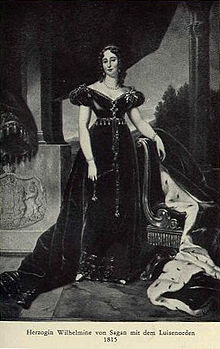Wilhelmine of Sagan
Wilhelmine von Sagan (born February 8, 1781 in Mitau ; † November 29, 1839 in Vienna ) from the house of Biron von Curland was Duchess of Sagan from 1800 to 1839 and owner of the Bohemian rule Nachod . With her influential political salon in Vienna and her liaison with the Austrian State Chancellor Prince Clemens von Metternich , she played an important political role in European diplomacy.
Life
Wilhelmine was born in Mitau, the capital of the Baltic Duchy of Courland , as Princess Katharina Friederike Wilhelmine Benigna of Courland . Her parents were Peter von Biron , Duke of Courland and Semigallia, and Dorothea , née Countess of Medem . Your tutor was Antonie Forster, a sister of the natural scientist Georg Forster . In addition, her aunt Elisa von der Recke exercised an educational influence. Since Wilhelmine had no brothers, her father declared her Hereditary Princess at the age of 15.
After the death of her father in 1800 Wilhelmine inherited the Silesian Duchy of Sagan, with which she was transferred from the Prussian King Friedrich Wilhelm III. was enfeoffed, as well as the rule Náchod in Bohemia . In 1809 , Friedrich Wilhelm von Braunschweig gathered a free corps at their Náchod Castle , which went down in history as the Black Group. It was under the protection of Austria and was to be used against France.
1810-1812 Wilhelmine left, belonging to the reign of Nachod Castle Ratibořice in Empire style rebuilt. Important preliminary political talks for the alliance against Napoleon Bonaparte took place there in June 1813 . During the Congress of Vienna in 1814/15 she lived next to her competitor, the Russian Princess Katharina Bagration , in the Palais Palm in Vienna , where she had a politically influential salon . In recognition of her services to the “liberation of Prussia from the French yoke”, King Friedrich Wilhelm III awarded her. after the end of the coalition wars the Order of Louis .
Wilhelmine von Sagan led an eventful and unsteady life between Vienna, Prague, Náchod, Ratibořice, Löbichau and Sagan . After failed marriages with Prince Louis von Rohan (1768–1836) and Prince Wassili Trubezkoi (1776–1841), she married Count Carl Rudolf von der Schulenburg (1788–1856) in 1819 .
Through her knowledge of the political constellations of Central and Eastern Europe and through connections to important personalities in England, France, Prussia and Russia, she made a contribution to the formation of a coalition against Napoleonic rule in Europe. Her liaison with the Austrian State Chancellor Prince Clemens von Metternich , whom she had known as ambassador at the Dresden court since his time, played an important role . She made several trips to Italy, England and France. In 1827 she entered Rome together with her youngest sister Dorothea , then divorced Countess de Talleyrand-Périgord and Duchess de Dino, to the Catholic faith.
The Czech writer Božena Němcová , who grew up in her environment as a servant's child, set Wilhelmine a literary monument in her novel “ Babička ” with the figure of the good, understanding Lady Princess. Wilhelmine died in Vienna in 1839. Her grave is in the cruciform church in Sagan . Her sister Pauline von Hohenzollern-Hechingen became the heir . Pauline later sold the castle and the Náchod estate to Octavio von Lippe-Biesterfeld and the Duchy of Sagan to her sister Dorothea, who thereby became Duchess of Sagan.
literature
- Constantin von Wurzbach : Sagan, Katharina Wilhelmine Friederike Benigne Duchess of . In: Biographisches Lexikon des Kaiserthums Oesterreich . 28th part. Kaiserlich-Königliche Hof- und Staatsdruckerei, Vienna 1874, pp. 65–68 ( digitized version ).
- Clemens Brühl: The Sagan . Berlin 1941.
- Maria Ulrichová (ed.): Clemens-Metternich - Wilhelmine von Sagan. An exchange of letters from 1813–1815 . Graz · Cologne, 1966.
- Dorothy Gies McGuigan: Wilhelmine von Sagan . Vienna · Munich 1994.
- Helena Sobková: Kateřina Zaháňská . Prague 1995.
- Günter Erbe : Wilhelmine von Sagan (1781−1839). In: Joachim Bahlcke (Ed.): Schlesische Lebensbilder , Volume 9. Insingen 2007, ISBN 978-3-7686-3506-6 , pp. 229-239.
Web links
| predecessor | Office | successor |
|---|---|---|
| Peter of Biron |
Duchess of Sagan 1800–1839 |
Maria Luise Pauline from Biron |
| personal data | |
|---|---|
| SURNAME | Wilhelmine of Sagan |
| ALTERNATIVE NAMES | Katharina Wilhelmine Biron of Sagan and Courland (real name); Kateřina Zaháňská (Czech) |
| BRIEF DESCRIPTION | Duchess of Sagan, Princess of Courland and Zemgale, owner of the Bohemian domain of Náchod |
| DATE OF BIRTH | February 8, 1781 |
| PLACE OF BIRTH | Mitau |
| DATE OF DEATH | November 29, 1839 |
| Place of death | Vienna |

